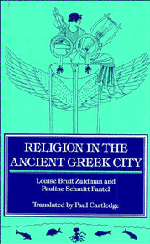Book contents
- Frontmatter
- Contents
- List of illustrations
- Author's preface to the English translation
- Translator's introduction
- List of sources
- PART I Introduction: How should we study Greek civic religion?
- PART II Cult-practices
- PART III Systems for representing the divine
- PART IV Envoi
- Appendixes
- I The classical Greek temple
- II The monuments of the Athenian Akropolis
- Bibliography
- Index
I - The classical Greek temple
Published online by Cambridge University Press: 05 June 2012
- Frontmatter
- Contents
- List of illustrations
- Author's preface to the English translation
- Translator's introduction
- List of sources
- PART I Introduction: How should we study Greek civic religion?
- PART II Cult-practices
- PART III Systems for representing the divine
- PART IV Envoi
- Appendixes
- I The classical Greek temple
- II The monuments of the Athenian Akropolis
- Bibliography
- Index
Summary
In chapter 6 we located the temple historically, geographically and functionally within the civic space of a city's public sanctuary. Here we add some technical details regarding its architectural details and illustrate them with a range of plans.
THE DIFFERENT PARTS
The basic plan (fig. 19) was rectangular and comprised two parts, one of which, the sēkos, was closed off, the other, the peristyle or exterior colonnade, open. The closed off part consisted of at least one room, the naos or in Latin cella, which housed the god's cult-statue. Often this room was entered from a pronaos or vestibule. A rear chamber (opisthodomos) completed the basic plan. In certain temples there was also an aduton (literally ‘a place to which access was barred’), a sort of holy-of-holies which communicated with the cella.
The disposition and number of columns determined the type of temple (figs. 19–20). A temple entirely surrounded by columns is said to be ‘peripteral’, and if the columns are ranged in two rows, ‘dipteral’. When there was only a single colonnade and that was placed on the façade, it is called ‘prostyle’ (fig. 20b). The number of columns on the façade is expressed in technical jargon as ‘hexastyle’ (six), ‘octostyle’ (eight), and so on. The length of temples varied considerably. The earliest, truly monumental ones measured a hundred feet (according to the local value for the foot), and hence were called ‘hundred-footers’ (hekatompeda).
- Type
- Chapter
- Information
- Religion in the Ancient Greek City , pp. 235 - 241Publisher: Cambridge University PressPrint publication year: 1992



